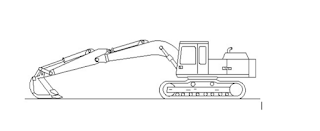
This guide primarily introduces the steps to disassemble and assemble the 3054C engine for Caterpillar 312D2 and 313D2 Excavators.
System Pressure Release
SMCS Codes: 4000-553-PX; 4350-553-PX; 5050-553-PX; 6700-553-PX
Before performing any repairs on the hydraulic circuit, it’s crucial to release the hydraulic pressure. This process must be completed before disconnecting or removing any hydraulic lines from the following circuits:
- Arm hydraulic loop
- Bucket bar hydraulic loop
- Bucket hydraulic loop
- Turn hydraulic circuit
- Drive hydraulic circuit
- Attachment hydraulic circuit (if provided)
- Pilot hydraulic circuit
- Reflow hydraulic circuit
Important Note: Refer to the Disassembly and Assembly manual for detailed information on specific hydraulic circuit components.
Steps to Release Hydraulic Pressure
Hydraulic oil under pressure can cause serious injuries. After the engine stops, hydraulic oil pressure remains in the system. Follow these steps to safely release the pressure before any repairs:
- Park the Machine
- Park the excavator on level ground.
- Lower the Implements
- Fully retract the bucket rod cylinder.
- Adjust the bucket position to be parallel to the ground.
- Lower the boom until the bucket is horizontal on the ground (See Illustration 1).
- Turn Off the Engine
- Turn Engine Start Switch On
- Turn the engine start switch to the “On” position without starting the engine.
- Unlock Hydraulic Start Control Lever
- Place the hydraulic start control lever in the unlock position.
- Release Pressure in Hydraulic Circuit
- Move the joystick or pedal of the hydraulic circuit to be repaired to the full position. This releases the high pressure in that circuit and any pressure in the pilot hydraulic circuit.
Note: If the hydraulic circuit requires an operating switch to be activated, do so at this step.
- Lock Hydraulic Start Control Lever
- Move the hydraulic start control lever to the locked position.
- Start the Engine
- Unlock Hydraulic Start Control Lever
- Without moving any joysticks or pedals, unlock the hydraulic start control lever.
- Lock Hydraulic Start Control Lever
- Move the hydraulic start control lever back to the locked position.
- Turn Off the Engine
- Repeat Steps for Other Circuits
- Repeat steps 4 to 11 for each hydraulic circuit that requires maintenance.
- Lock Hydraulic Start Control Lever
- After releasing the pressure in each circuit, lock the hydraulic start lever.
- Turn Off Engine Start Switch
- Turn the engine start switch to the off position.
- Release Pressure from Hydraulic Tank
- Slowly release the filler plug on the hydraulic tank to release any remaining pressure. Keep the plug loose for at least 45 seconds.
- Tighten Filler Plug
- Tighten the filler plug to the specified torque.
- Hydraulic Pressure Released
- With the pressure released, you can now disconnect or remove lines and components from the hydraulic circuits.
For more details on the Caterpillar ET software and diagnostic tools, refer to the special publications and diagnostic tool manuals. Always dispose of liquids according to local regulations and requirements.
Tools and Supplies
- Refer to NENG2500, “Agent Repair Tool Catalogue” for applicable tools and supplies for collecting and filling fluids on Cat products.
Leave a Reply